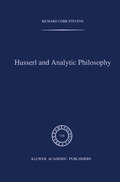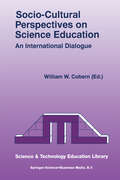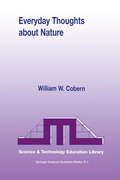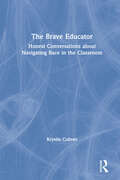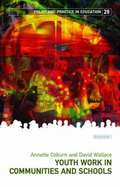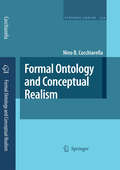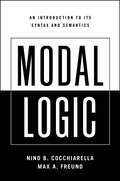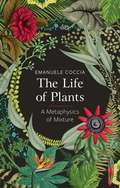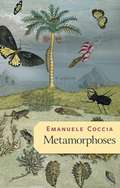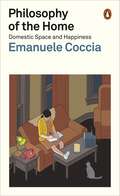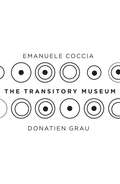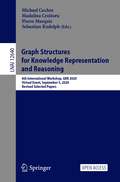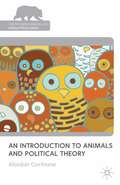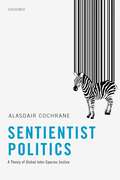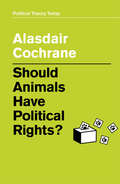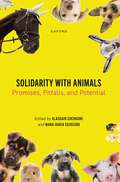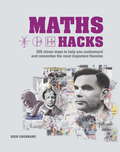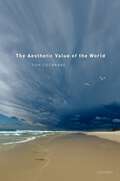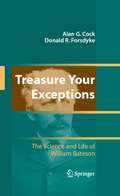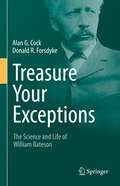- Table View
- List View
Husserl and Analytic Philosophy (Phaenomenologica #116)
by R. Cobb-StevensThe principal differences between the contemporary philosophic traditions which have come to be known loosely as analytic philosophy and phenomenology are all related to the central issue of the interplay between predication and perception. Frege's critique of psychologism has led to the conviction within the analytic tradition that philosophy may best defend rationality from relativism by detaching logic and semantics from all dependence on subjective intuitions. On this interpretation, logical analysis must account for the relationship of sense to reference without having recourse to a description of how we identify particulars through their perceived features. Husserl' s emphasis on the priority and objective import of perception, and on the continuity between predicative articulations and perceptual discriminations, has yielded the conviction within the phenomenological tradition that logical analysis should always be comple mented by description of pre-predicative intuitions. These methodological differences are related to broader differences in the philosophic projects of analysis and phenomenology. The two traditions have adopted markedly divergent positions in reaction to the critique of ancient and medieval philosophy initiated by Bacon, Descartes, and Hobbes at the beginning of the modern era. The analytic approach generally endorses the modern preference for calculative rationality and remains suspicious of pre-modern categories, such as formal causality and eidetic intuition. Its goal is to give an account of human intelligence that is compatible with the modern interpretation of nature as an ensemble of quantifiable entities and relations.
Socio-Cultural Perspectives on Science Education: An International Dialogue (Contemporary Trends and Issues in Science Education #4)
by William W. CobernGlobal science education is a reality at the end of the 20th century - albeit an uneven reality - because of tremendous technological and economic pressures. Unfortunately, this reality is rarely examined in the light of what interests the everyday lives of ordinary people rather than the lives of political and economic elites. The purpose of this book is to offer insightful and thought-provoking commentary on both realities. The tacit question throughout the book is `Whose interests are being served by current science education practices and policies?' The various chapters offer critical analysis from the perspectives of culture, economics, epistemology, equity, gender, language, and religion in an effort to promote a reflective science education that takes place within, rather than taking over, the important cultural lives of people. The target audience for the book includes graduate students in education, science education and education policy professors, policy and government officials involved with education.
Everyday Thoughts about Nature: A Worldview Investigation of Important Concepts Students Use to Make Sense of Nature with Specific Attention of Science (Contemporary Trends and Issues in Science Education #9)
by W.W. CobernThe Brave Educator: Honest Conversations about Navigating Race in the Classroom
by Krystle CobranThe Brave Educator equips you with accessible and refreshingly useful tools for real conversations about race that prepare students for the world beyond the school walls. More than a toolkit, this book is a personal conversation exploring the journey from being stuck in the belief that we should already know how to lead conversations about race to learning how to actually have the conversation. It’s companionship for educators, leaders, and teachers facing overwhelming daily responsibilities and searching for open-hearted support. Inside you’ll find a flexible road map to help carve a path through difficult conversations in your classroom, plus question prompts, resource lists, and crucial tips to help you avoid common pitfalls. The grounded perspective and real-world examples in these pages will help you feel less alone as you move from tentative to prepared.
The Brave Educator: Honest Conversations about Navigating Race in the Classroom
by Krystle CobranThe Brave Educator equips you with accessible and refreshingly useful tools for real conversations about race that prepare students for the world beyond the school walls. More than a toolkit, this book is a personal conversation exploring the journey from being stuck in the belief that we should already know how to lead conversations about race to learning how to actually have the conversation. It’s companionship for educators, leaders, and teachers facing overwhelming daily responsibilities and searching for open-hearted support. Inside you’ll find a flexible road map to help carve a path through difficult conversations in your classroom, plus question prompts, resource lists, and crucial tips to help you avoid common pitfalls. The grounded perspective and real-world examples in these pages will help you feel less alone as you move from tentative to prepared.
Youth Work in Communities and Schools (Policy And Practice In Education Ser. #28)
by Annette Coburn David WallaceWorking across professional and disciplinary boundaries, young people and youth workers collaborate to create powerful learning environments in communities, schools and other settings. The authors explore how youth work, as a critical and problem-posing pedagogy, enables young people to transform their lives
Formal Ontology and Conceptual Realism (Synthese Library #339)
by Nino B. CocchiarellaTheories about the ontological structure of the world have generally been described in informal, intuitive terms. This book offers an account of the general features and methodology of formal ontology. The book defends conceptual realism as the best system to adopt based on a logic of natural kinds. By formally reconstructing an intuitive, informal ontological scheme as a formal ontology we can better determine the consistency and adequacy of that scheme.
Modal Logic: An Introduction to its Syntax and Semantics
by Nino B. Cocchiarella Max A. FreundIn this text, a variety of modal logics at the sentential, first-order, and second-order levels are developed with clarity, precision and philosophical insight. All of the S1-S5 modal logics of Lewis and Langford, among others, are constructed. A matrix, or many-valued semantics, for sentential modal logic is formalized, and an important result that no finite matrix can characterize any of the standard modal logics is proven. Exercises, some of which show independence results, help to develop logical skills. A separate sentential modal logic of logical necessity in logical atomism is also constructed and shown to be complete and decidable. On the first-order level of the logic of logical necessity, the modal thesis of anti-essentialism is valid and every de re sentence is provably equivalent to a de dicto sentence. An elegant extension of the standard sentential modal logics into several first-order modal logics is developed. Both a first-order modal logic for possibilism containing actualism as a proper part as well as a separate modal logic for actualism alone are constructed for a variety of modal systems. Exercises on this level show the connections between modal laws and quantifier logic regarding generalization into, or out of, modal contexts and the conditions required for the necessity of identity and non-identity. Two types of second-order modal logics, one possibilist and the other actualist, are developed based on a distinction between existence-entailing concepts and concepts in general. The result is a deeper second-order analysis of possibilism and actualism as ontological frameworks. Exercises regarding second-order predicate quantifiers clarify the distinction between existence-entailing concepts and concepts in general. Modal Logic is ideally suited as a core text for graduate and undergraduate courses in modal logic, and as supplementary reading in courses on mathematical logic, formal ontology, and artificial intelligence.
The Life of Plants: A Metaphysics of Mixture
by Emanuele CocciaWe barely talk about them and seldom know their names. Philosophy has always overlooked them; even biology considers them as mere decoration on the tree of life. And yet plants give life to the Earth: they produce the atmosphere that surrounds us, they are the origin of the oxygen that animates us. Plants embody the most direct, elementary connection that life can establish with the world. In this highly original book, Emanuele Coccia argues that, as the very creator of atmosphere, plants occupy the fundamental position from which we should analyze all elements of life. From this standpoint, we can no longer perceive the world as a simple collection of objects or as a universal space containing all things, but as the site of a veritable metaphysical mixture. Since our atmosphere is rendered possible through plants alone, life only perpetuates itself through the very circle of consumption undertaken by plants. In other words, life exists only insofar as it consumes other life, removing any moral or ethical considerations from the equation. In contrast to trends of thought that discuss nature and the cosmos in general terms, Coccia’s account brings the infinitely small together with the infinitely big, offering a radical redefinition of the place of humanity within the realm of life.
The Life of Plants: A Metaphysics of Mixture
by Emanuele CocciaWe barely talk about them and seldom know their names. Philosophy has always overlooked them; even biology considers them as mere decoration on the tree of life. And yet plants give life to the Earth: they produce the atmosphere that surrounds us, they are the origin of the oxygen that animates us. Plants embody the most direct, elementary connection that life can establish with the world. In this highly original book, Emanuele Coccia argues that, as the very creator of atmosphere, plants occupy the fundamental position from which we should analyze all elements of life. From this standpoint, we can no longer perceive the world as a simple collection of objects or as a universal space containing all things, but as the site of a veritable metaphysical mixture. Since our atmosphere is rendered possible through plants alone, life only perpetuates itself through the very circle of consumption undertaken by plants. In other words, life exists only insofar as it consumes other life, removing any moral or ethical considerations from the equation. In contrast to trends of thought that discuss nature and the cosmos in general terms, Coccia’s account brings the infinitely small together with the infinitely big, offering a radical redefinition of the place of humanity within the realm of life.
Metamorphoses
by Emanuele CocciaWe are all fascinated by the mystery of metamorphosis – of the caterpillar that transforms itself into a butterfly. Their bodies have almost nothing in common. They don’t share the same world: one crawls on the ground and the other flutters its wings in the air. And yet they are one and the same life. Emanuele Coccia argues that metamorphosis – the phenomenon that allows the same life to subsist in disparate bodies – is the relationship that binds all species together and unites the living with the non-living. Bacteria, viruses, fungi, plants, animals: they are all one and the same life. Each species, including the human species, is the metamorphosis of all those that preceded it – the same life, cobbling together a new body and a new form in order to exist differently. And there is no opposition between the living and the non-living: life is always the reincarnation of the non-living, a carnival of the telluric substance of a planet – the Earth – that continually draws new faces and new ways of being out of even the smallest particle of its disparate body. By highlighting what joins humans together with other forms of life, Coccia’s brilliant reflection on metamorphosis encourages us to abandon our view of the human species as static and independent and to recognize instead that we are part of a much larger and interconnected form of life.
Metamorphoses
by Emanuele CocciaWe are all fascinated by the mystery of metamorphosis – of the caterpillar that transforms itself into a butterfly. Their bodies have almost nothing in common. They don’t share the same world: one crawls on the ground and the other flutters its wings in the air. And yet they are one and the same life. Emanuele Coccia argues that metamorphosis – the phenomenon that allows the same life to subsist in disparate bodies – is the relationship that binds all species together and unites the living with the non-living. Bacteria, viruses, fungi, plants, animals: they are all one and the same life. Each species, including the human species, is the metamorphosis of all those that preceded it – the same life, cobbling together a new body and a new form in order to exist differently. And there is no opposition between the living and the non-living: life is always the reincarnation of the non-living, a carnival of the telluric substance of a planet – the Earth – that continually draws new faces and new ways of being out of even the smallest particle of its disparate body. By highlighting what joins humans together with other forms of life, Coccia’s brilliant reflection on metamorphosis encourages us to abandon our view of the human species as static and independent and to recognize instead that we are part of a much larger and interconnected form of life.
Philosophy of the Home: Domestic Space and Happiness
by Emanuele CocciaA bedroom, a kitchen, a bathroom - are these rooms all that make a home? Not at all, argues Emanuele Coccia. The buildings we inhabit are of immense psychological and cultural significance. They play a decisive role in human flourishing and, for hundreds of years, their walls and walkways, windows and doorways have guided our relationships with others and with ourselves. They reflect and reinforce social inequalities; they allow us to celebrate and cherish those we love. They are the places of return that allow us to venture out into the world.In this intimate, elegantly argued account, Coccia shows how the architecture of home has shaped, and continues to shape, our psyches and our societies, before then masterfully leading us towards a more creative, ecological way of dwelling in the world.
The Transitory Museum
by Emanuele Coccia Donatien GrauThroughout modernity there has been a clear divide between art and commerce. Objects could either be consumed as commerce or contemplated as art. Today, as museums are facing increasing financial pressure and as stores have become inventive locations for new modes of display, this clear divide has begun to dissolve. There is one place that represents a key stage in this evolution: 10 Corso Como. It was founded in Milan, at that very address, by fashion editor Carla Sozzani and has since expanded to Seoul, Beijing, Shanghai, and New York. The name “concept store”, which has now spread across our globalized world, was originally coined to describe this new form. This book is the first philosophical inquiry into this new form of store and it sheds new light on how categories that have governed our modern lives, such as commerce, art, fashion, and museum, are being redefined today.
Graph Structures for Knowledge Representation and Reasoning: 6th International Workshop, GKR 2020, Virtual Event, September 5, 2020, Revised Selected Papers (Lecture Notes in Computer Science #12640)
by Michael Cochez Madalina Croitoru Pierre Marquis Sebastian RudolphThis open access book constitutes the thoroughly refereed post-conference proceedings of the 6th International Workshop on Graph Structures for Knowledge Representation and Reasoning, GKR 2020, held virtually in September 2020, associated with ECAI 2020, the 24th European Conference on Artificial Intelligence.The 7 revised full papers presented together with 2 invited contributions were reviewed and selected from 9 submissions. The contributions address various issues for knowledge representation and reasoning and the common graph-theoretic background, which allows to bridge the gap between the different communities.
An Introduction to Animals and Political Theory (The Palgrave Macmillan Animal Ethics Series)
by Alasdair CochraneStructured around the five most important schools within contemporary political theory: liberalism, utilitarianism, communitarianism, Marxism and feminism, this is the first introductory level text to offer an accessible overview on the status of animals in contemporary political theory.
Sentientist Politics: A Theory of Global Inter-Species Justice
by Alasdair CochraneThere is now widespread agreement that many non-human animals are sentient, and that this fact has important moral and political implications. Indeed, most are in agreement that animal sentience ought to constrain the actions of political institutions, limiting the harms that can be perpetrated against animals. The primary aim of this book is to show that the political implications of animal sentience go even further than this. For this book argues that sentience establishes a moral equality and a shared set of rights amongst those creatures who possess it. Crucially, this worth and these rights create a duty on moral agents to establish and maintain a political order dedicated to their interests. This book is devoted to sketching what this 'sentientist politics' might look like. It argues in favour of a ' sentientist cosmopolitan democracy': a global political system made up of overlapping local, national, regional and global communities comprised of human and non-human members who exist within shared 'communities of fate'. Furthermore, the institutions of those communities should be democratic - that is to say, participative, deliberative and representative. Finally, those institutions should include dedicated representatives of non-human animals whose job should be to translate the interests of animals into deliberations over what is in the public good for their communities.
Sentientist Politics: A Theory of Global Inter-Species Justice
by Alasdair CochraneThere is now widespread agreement that many non-human animals are sentient, and that this fact has important moral and political implications. Indeed, most are in agreement that animal sentience ought to constrain the actions of political institutions, limiting the harms that can be perpetrated against animals. The primary aim of this book is to show that the political implications of animal sentience go even further than this. For this book argues that sentience establishes a moral equality and a shared set of rights amongst those creatures who possess it. Crucially, this worth and these rights create a duty on moral agents to establish and maintain a political order dedicated to their interests. This book is devoted to sketching what this 'sentientist politics' might look like. It argues in favour of a ' sentientist cosmopolitan democracy': a global political system made up of overlapping local, national, regional and global communities comprised of human and non-human members who exist within shared 'communities of fate'. Furthermore, the institutions of those communities should be democratic - that is to say, participative, deliberative and representative. Finally, those institutions should include dedicated representatives of non-human animals whose job should be to translate the interests of animals into deliberations over what is in the public good for their communities.
Should Animals Have Political Rights? (Political Theory Today)
by Alasdair CochraneAll political communities must make decisions about how to regulate the treatment of animals. Most states currently protect animals through outlawing the infliction of ‘unnecessary suffering’. But do animals’ rights end there? In this book, Alasdair Cochrane argues that states must go much further. Animals have rights to be protected not only from the cruelty of individuals, but also from those structures and institutions which routinely (and, in some cases, necessarily) cause them harm, such as industrialised animal agriculture. But even that isn’t adequate. In order to ensure that their interests are taken seriously, it is imperative that we represent their interests throughout the political process – they require not only rights to protection, but also to democratic membership. Cochrane’s important intervention in this controversial debate will be essential reading for anyone interested in the intersection of political theory and animal rights.
Solidarity with Animals: Promises, Pitfalls, and Potential
by Alasdair Cochrane'Solidarity' has received considerable scholarly attention and is central in many social justice movements. It is striking, then, that solidarity's relevance, meaning and practical implications in the context of animal protection have not been systematically explored. This is particularly surprising given the recent so-called 'political turn' in animal ethics. Work in the political turn accepts claims about the moral status of animals and people's personal obligations towards them, but advances the field in at least two ways. First, thinkers emphasize that mutually beneficial human-animal relations cannot rely solely on personal transformation, but also require institutional transformation. Secondly, scholars claim that to meaningfully improve the lives of animals, we must not only change our political systems, but better understand various animals' own perspectives and political agency to feed into 'more-than-human politics'. But while much work in this political turn has been done on concepts like 'justice', 'agency', 'representation', etc., only very few animal scholars have talked about 'solidarity'. And those that have, have done so only in very specific contexts and frameworks. This lack of attention is also mirrored also within animal activism, where those few campaigners who have employed the term have done so only in a very loose way. This edited collection brings together the leading thinkers in the fields of animal ethics, politics, social philosophy, world religions, and the law to explore this lacuna and thus provide the first book length treatment of solidarity between the species.
Maths Hacks (Hacks)
by Richard CochraneEverything you need to know about 100 key mathematical concepts condensed into easy-to-understand sound bites designed to stick in your memory and give you an instant grasp of the concept.On each topic, you'll start with a helicopter overview of the subject, which will give you an introduction to the idea and some context surrounding it. Next, you'll zoom in on the core elements of the theory, with clear explanation of each point to make sure you really understand the concept, along with simple examples that everyone can follow. Finally, you'll be given a one-liner hack to really make the theory stick in your mind. The perfect introduction to algebra, logic, probability and much more, this is a great new way to learn about the most important mathematical ideas and concepts in a way that makes them easy to recall even months after reading the book.Topics covered include:NumbersAlgebraLogicGeometryProbabilityComputer scienceApplied mathematicsMechanicsStatisticsSet Theory
The Aesthetic Value of the World
by Tom CochraneIn The Aesthetic Value of the World, Tom Cochrane defends Aestheticism, the claim that everything is aesthetically valuable and that a life lived in pursuit of aesthetic value can be a particularly good one. Furthermore, in distilling aesthetic qualities, artists have a special role to play in teaching us to recognize values; a critical component of virtue. Cochrane grounds his account upon an analysis of aesthetic value as 'objectified final value', which is underwritten by an original psychological claim that all aesthetic values are distal versions of practical values. This is followed by systematic accounts of beauty, sublimity, comedy, drama, and tragedy, as well as appendix entries on the cute, the cool, the kitsch, the uncanny, the horrific, the erotic, and the furious.
The Aesthetic Value of the World
by Tom CochraneIn The Aesthetic Value of the World, Tom Cochrane defends Aestheticism, the claim that everything is aesthetically valuable and that a life lived in pursuit of aesthetic value can be a particularly good one. Furthermore, in distilling aesthetic qualities, artists have a special role to play in teaching us to recognize values; a critical component of virtue. Cochrane grounds his account upon an analysis of aesthetic value as 'objectified final value', which is underwritten by an original psychological claim that all aesthetic values are distal versions of practical values. This is followed by systematic accounts of beauty, sublimity, comedy, drama, and tragedy, as well as appendix entries on the cute, the cool, the kitsch, the uncanny, the horrific, the erotic, and the furious.
Treasure Your Exceptions: The Science and Life of William Bateson
by Alan Cock Donald R. ForsdykeThis biography provides an understanding of William Bateson as well as a reconciliation of diverging views (e.g. the hierarchical thinking of Gould and the genocentrism of George Williams and Richard Dawkins). Evolutionists may thus, at long last, present a unified front to their creationist opponents. The pressing need for this text is apparent from the high percentages reported not to believe in evolution and the growth of the so-called "intelligent design" movement.
Treasure Your Exceptions: The Science and Life of William Bateson
by Alan G. Cock Donald R. ForsdykeThis biography provides an understanding of William Bateson as well as a reconciliation of diverging views (e.g. the hierarchical thinking of Gould and the genocentrism of George Williams and Richard Dawkins). Evolutionists may thus, at long last, present a unified front to their creationist opponents. The pressing need for this text is apparent from the high percentages reported not to believe in evolution and the growth of the so-called "intelligent design" movement.
